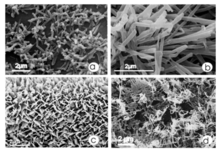Epicuticular wax
Epicuticular wax is a
Chemical composition
Common constituents of epicuticular wax are predominantly straight-chain

These waxes can be composed of a variety of compounds which differ between plant species. Wax tubules and wax platelets often have chemical as well as morphological differences. Tubules can be separated into two groups; the first primarily containing secondary alcohols, and the second containing β-diketones. Platelets are either dominated by triterpenoids, alkanes, aldehydes, esters, secondary alcohols, or flavonoids. However, chemical composition is not diagnostic of a tubule or platelet, as this does not determine the morphology.[3]
Farina
Many species of the genus Primula and ferns, such as Cheilanthes, Pityrogramma and Notholaena, as well as many genera of Crassulaceae succulent plants, produce a mealy, whitish to pale-yellow glandular secretion known as farina that is not an epicuticular wax, but consists largely of crystals of a different class of polyphenolic compounds known as flavonoids.[5] Unlike epicuticular wax, farina is secreted by specialised glandular hairs, rather than by the cuticle of the entire epidermis.[5]
Physical properties

Epicuticular waxes are mostly solids at ambient temperature, with melting points above about 40 °C (100 °F). They are soluble in organic solvents such as
Epicuticular wax can reflect UV light, such as the white, chalky, wax coating of
The term 'glaucous' is used to refer to any foliage, such as that of the family Crassulaceae, which appears whitish because of the waxy covering. Coatings of epicuticular flavonoids may be referred to as 'farina', the plants themselves being described as 'farinose' or 'farinaceous'.[10]: 51
Epicuticular wax crystals
Epicuticular wax forms crystalline projections from the plant surface, which enhance their water repellency,
Measurement techniques
Epicuticular waxes are recovered from terrestrial, marine, and lake environments, allowing for solvent extraction of biomarkers and then qualitative and quantitative profiling through Gas Chromatography Mass Spectrometry (GC-MS) and GC Flame Ionization Detection (GC-FID). GC-MS and GC-FID are preferential for identifying and quantifying n-alkanes and n-alkanoic acids. Isotope ratio analysis (GC-IRMS) measures relative abundance of carbon, hydrogen, and other isotopes with high precision. The carbon isotopic ratio is expressed between carbon-13 and carbon-12 as δ13C relative to the international standard. The hydrogen isotopic ratio between deuterium and protium is expressed as δD relative to the international standard.[19]
Use as a biomarker

[19] Epicuticular wax has been used as a biomarker to observe human evolution patterns. These lipids of these plant waxes have been analyzed when extracted from ocean and lake cores, paleo-lake drilling projects, archeological and geological outcrops, cave deposits, and human-bearing sediments. This data provides insight into past plant ecology and environmental stresses, particularly by reconstructing landscapes at a high taxonomic resolution.
Epicuticular wax δ13C is a favorable biomarker due to its benefits: it is not biased towards feeding like tooth enamel biomarkers, and are more widespread than paleosol carbonates that are biased based on rainfall amount. This marker can also identify C3 and C4 photosynthetic pathways. Biosynthesis of these lipids result in further fractionation that results in lighter the bulk δ13C. Isotope stability studies that characterize diagenetic process can identify carbon and hydrogen alteration through chemical and microbial activity, but these studies often have mixed results. The state of plant wax preservation in soils and sediments is still unknown due to complex interactions in the depositional environments, including pH, microbial communities, alkalinity, temperature, and oxygen/moisture content.
δ13C of higher order plants has been used at

Epicuticular wax and its successor aliphatic compounds are also used as biomarkers for higher plants. Long-chain n-alkyl compounds from vascular plants leaves are major components of epicuticular waxes that are resistant to degradation and thus effective biomarkers for higher plants. These terrestrial biomarkers can also be present in marine sediments. Due to the lack of higher plant material in aqueous settings, the presence of higher plant biomarkers in these ecosystems infer that these biomarkers were transported from their original terrestrial environment. Carbon isotopic compositions, specifically, their δ13C value, reflect their metabolism and environment, as 13C is discriminated against during photosynthesis.[20]
See also
References
- ^ ISBN 0-12-199920-3.
- ISBN 0521781582.
- ^ ISSN 1934-578X.
- ^ Holloway, P.J.; Jeffree, C.E. (2005). "Epicuticular waxes". Encyclopedia of Applied Plant Sciences. 3: 1190–1204.
- ^ .
- S2CID 92392.
- .
- PMID 27466439.
- S2CID 23753011.
- ISBN 978-1-84246-604-9.
- .
- S2CID 37872229.
- ^ OCLC 225630715.
- .
- .
- ^ Jeffree, C. E. (2006). "The fine structure of the Plant Cuticle". In Riederer, M.; Müller, C. (eds.). Biology of the Plant Cuticle. Blackwell Publishing. pp. 11–125. Archived from the original on April 6, 2007.
- PMID 14966216.
- S2CID 20775168.
- ^ S2CID 236960097– via Wiley Online Library.
- ^ ISSN 0304-4203.
Bibliography
- Eigenbrode, S. D. (1996). "Plant surface waxes and insect behaviour". In Kerstiens, G. (ed.). Plant Cuticles: an integrated functional approach. Oxford: Bios Scientific Publishers. pp. 201–221. ISBN 1-85996-130-4.
